GRU-ESO Strategy for a Distributed Coil Magnetically Levitated Planar Micromotor
Abstract
1. Introduction
2. Distributed Coil Magnetically Levitated Planar Micromotor and System Modeling
2.1. Design of a Distributed Coil Magnetically Levitated Planar Micromotor
2.2. System Modeling
2.2.1. Analysis of the Magnetic Field Density
2.2.2. Analysis of the Electromagnetic Force
2.2.3. Analysis of the System Model
3. Design of the Controller
3.1. Design of ESO
3.2. Design of GRU Control
3.3. Design of GRU-ESO Controller
4. Experimental Results and Discussion
4.1. Setup and Control of Experiments
- is the root-mean-square (RMS) value of the tracking error, where T is the total time;
- is the maximal (M) absolute value of the tracking error over the total time.
- 1.
- Set 1: To verify the nominal tracking performance, the experiment is run without disturbances, i.e., and payload.
- 2.
- Set 2: To verify the robustness to unknown external disturbances, random external and internal disturbances were added to the control input.
- 3.
- Set 3: To verify the robustness to unknown external disturbances and parameter uncertainties, based on Set 2, a 1 kg payload is added on the mover.
4.2. Results and Discussions of Experiments
5. Conclusions
6. Patents
Author Contributions
Funding
Data Availability Statement
Acknowledgments
Conflicts of Interest
Appendix A
References
- Ou, T.; Hu, C.; Zhu, Y.; Zhang, M. Generation Mechanism and Decoupling Strategy of Coupling Effect in Maglev Planar Motor. IEEE/ASME Trans. Mechatron. 2023, 28, 781–791. [Google Scholar] [CrossRef]
- Xu, R.; Xu, Q. A Survey of Recent Developments in Magnetic Microrobots for Micro-/Nano-Manipulation. Micromachines 2024, 15, 468. [Google Scholar] [CrossRef] [PubMed]
- Zhou, L.; Wu, J. Magnetic Levitation Technology for Precision Motion Systems: A Review and Future Perspectives. Int. J. Autom. Technol. 2022, 16, 386–402. [Google Scholar] [CrossRef]
- Lahdo, M.; Ströhla, T.; Kovalev, S. Design and Implementation of A New 6-DoF Magnetic Levitation Positioning System. IEEE Trans. Magn. 2019, 55, 1–7. [Google Scholar] [CrossRef]
- Heyman, I.L.; Wu, J.; Zhou, L. Lev Cube: A Six-Degree-of-Freedom Magnetically Levitated Nanopositioning Stage with Centimeter-Range XYZ Motion. Precis. Eng. 2023, 83, 102–111. [Google Scholar] [CrossRef]
- Zou, M.; Song, M.; Zhou, S.; Xu, X.; Xu, F. Force and Torques Model of Magnetically Levitated System with 2D Halbach Array and Printed Circuit Board Coils. Sensors 2023, 23, 8735. [Google Scholar] [CrossRef] [PubMed]
- Chiem, N.X.; Thang, L.T. Synthesis of Hybrid Fuzzy Logic Law for Stable Control of Magnetic Levitation System. J. Robot. Control 2023, 4, 141–148. [Google Scholar] [CrossRef]
- Zhang, L.; Kou, B. Investigation of A Novel 2-D Halbach Magnet Array for Magnetically Levitated Planar Motor. In Proceedings of the 2017 20th International Conference on Electrical Machines and Systems (ICEMS), Sydney, NSW, Australia, 11–14 August 2017; pp. 1–5. [Google Scholar]
- Wang, Y.; Chen, F.; Zheng, Z.; Zeng, L. Magnet array of Planar Motor Using Permanent Magnets with Different Magnetisation Intensity and Height. IET Electr. Power Appl. 2021, 14, 2772–2779. [Google Scholar] [CrossRef]
- Huang, S.; Luo, W.; Zhu, Z. Experimental and Theoretical Analysis of A Hybrid Vibration Energy Harvester with Integrated Piezoelectric and Electromagnetic Interaction. J. Zhejiang Univ. Sci. A 2023, 24, 991–1002. [Google Scholar] [CrossRef]
- Jansen, J.W.; Lierop, C.M.M.; Lomonova, E.A.; Vandenput, A.J.A. Magnetically Levitated Planar Actuator with Moving Magnets. IEEE Trans. Ind. Appl. 2008, 44, 1108–1115. [Google Scholar] [CrossRef]
- Basovich, S.; Arogeti, S.A.; Menaker, Y.; Brand, Z. Magnetically Levitated Six-DOF Precision Positioning Stage with Uncertain Payload. IEEE/ASME Trans. Mechatron. 2015, 21, 660–673. [Google Scholar] [CrossRef]
- Zhou, Y.; Kou, B.; Zhang, H.; Zhang, L.; Wang, L. Design, Analysis and Test of a Hyperbolic Magnetic Field Voice Coil Actuator for Magnetic Levitation Fine Positioning Stage. Energies 2019, 12, 1830. [Google Scholar] [CrossRef]
- Hu, C.; Fu, H.; Zhu, Y.; Zhang, M. A 6-DOF Extended Unified Wrench Model for Maglev Planar Motor. IEEEASME Trans. Mechatron. 2024, 1, 1–11. [Google Scholar] [CrossRef]
- Carneiro, J.F.; Pinto, J.B.; De Almeida, F.G. Accurate Motion Control of a Pneumatic Linear Peristaltic Actuator. Actuators 2020, 9, 63. [Google Scholar] [CrossRef]
- Chen, Y.F.; Chang, H. Study on Structural Optimization Design and Cascade PID Control of Maglev Actuator for Active vibration Isolation System. J. Vib. Control 2018, 24, 1829–1847. [Google Scholar]
- Jin, J.J.P. Simulation of Hydraulic Transplanting Robot Control System Based on Fuzzy PID Controller. Measurement 2020, 164, 1. [Google Scholar] [CrossRef]
- Zhou, H.; Deng, H.; Duan, J. Hybrid Fuzzy Decoupling Control for a Precision Maglev Motion System. IEEE/ASME Trans. Mechatron. 2018, 23, 389–401. [Google Scholar] [CrossRef]
- Geng, J.; Yu, X.; Wu, C.; Zhang, G. Research on Pedestrian Indoor Positioning Based on Two-Step Robust Adaptive Cubature Kalman Filter with Smartphone MEMS Sensors. Micromachines 2023, 14, 1252. [Google Scholar] [CrossRef] [PubMed]
- Hu, C.; Wang, Z.; Zhu, Y.; Zhang, M.; Liu, H. Performance-Oriented Precision LARC Tracking Motion Control of a Magnetically Levitated Planar Motor with Comparative Experiments. IEEE Trans. Ind. Electron. 2016, 63, 5763–5773. [Google Scholar] [CrossRef]
- Yan, B.; Wang, X.; Ma, H.; Lu, W.; Li, Q. Hybrid Time-delayed Feedforward and Feedback Control of Lever-type Quasi-zero-stiffness Vibration Isolators. IEEE Trans. Ind. Electron. 2024, 71, 2810–2819. [Google Scholar] [CrossRef]
- Ma, T.; Wang, B.; Wang, Z. MPC-ESO Position Control Strategy for a Miniature Double-Cylinder Actuator Considering Hose Effects. Micromachines 2023, 14, 1201. [Google Scholar] [CrossRef] [PubMed]
- Huang, D.; Xu, J.X.; Venkataramanan, V.; Huynh, T.C.T. High-Performance Tracking of Piezoelectric Positioning Stage Using Current-Cycle iterative Learning Control with Gain Scheduling. IEEE Trans. Ind. Electron. 2014, 61, 1085–1098. [Google Scholar] [CrossRef]
- Rauh, A.; Chevet, T.; Dinh, T.N.; Marzat, J.; Raïssi, T. Robust Iterative Learning Observers Based on a Combination of Stochastic Estimation Schemes and Ellipsoidal Calculus. In Proceedings of the 2022 25th International Conference on Information Fusion (FUSION), Linköping, Sweden, 4–7 July 2022; pp. 1–8. [Google Scholar]
- Cheng, L.; Liu, W.; Yang, C.; Huang, T.; Hou, Z.-G.; Tan, M. A Neural-Network-Based Controller for Piezoelectric-Actuated Stick–Slip Devices. IEEE Trans. Ind. Electron. 2018, 3, 20–29. [Google Scholar] [CrossRef]
- Wang, Z.; Hu, C.; Zhu, Y.; He, S.; Yang, K.; Zhang, M. Neural Network Learning Adaptive Robust Control of an Industrial Linear Motor-Driven Stage with Disturbance Rejection Ability. IEEE Trans. Ind. Inform. 2017, 13, 2172–2183. [Google Scholar] [CrossRef]
- Hu, C.; Ou, T.; Chang, H. Deep GRU Neural-Network Prediction and Feedforward Compensation for Precision Multi-Axis Motion Control Systems. IEEE/ASME Trans. Mechatron. 2020, 25, 1377–1388. [Google Scholar] [CrossRef]
- Jiang, C.; Du, C.; Ming, Z. Design and Research of Distributed Coil Magnetic Levitation Platform. In Proceedings of the 2022 International Conference on Wireless Power Transfer (ICWPT2022). ICWPT 2022, Chongqing, China, 28–31 October 2022; Lecture Notes in Electrical Engineering. Springer: Singapore, 2022; Volume 1018, pp. 1069–1075. [Google Scholar]
- de Boeij, J.; Lomonova, E.; Vandenput, A. Modeling Ironless Permanent-Magnet Planar Actuator Structures. IEEE Trans. Magn. 2006, 42, 2009–2016. [Google Scholar] [CrossRef]
- Jansen, J.W.; Van Lierop, C.M.M.; Lomonova, E.A.; Vandenput, A.J.A. Modeling of Magnetically Levitated Planar Actuators with Moving Magnets. IEEE Trans. Magn. 2007, 43, 15–25. [Google Scholar] [CrossRef]
- Zhao, H.; Chen, S.; Li, M. A Sufficient Condition for The Stability of The Third-Order Extended State Observer. In Proceedings of the 32nd Chinese Control Conference, Xi’an, China, 26–28 July 2013; pp. 1526–1531. [Google Scholar]
- Cho, K.; van Merrienboer, B.; Gulcehre, C.; Bahdanau, D.; Bougares, F.; Schwenk, H.; Bengio, Y. Learning Phrase Representations using RNN Encoder-Decoder for Statistical Machine Translation. In Proceedings of the 2014 Conference on Empirical Methods in Natural Language Processing (EMNLP), Doha, Qatar, 25–29 October 2014; pp. 1724–1734. [Google Scholar]
- Wu, J. Aircraft Trajectory Prediction Based on Long and Short-Term Memory Structural Models. In Proceedings of the 2024 International Conference on Distributed Computing and Optimization Techniques (ICDCOT), Bengaluru, India, 15–16 March 2024; pp. 1–5. [Google Scholar]
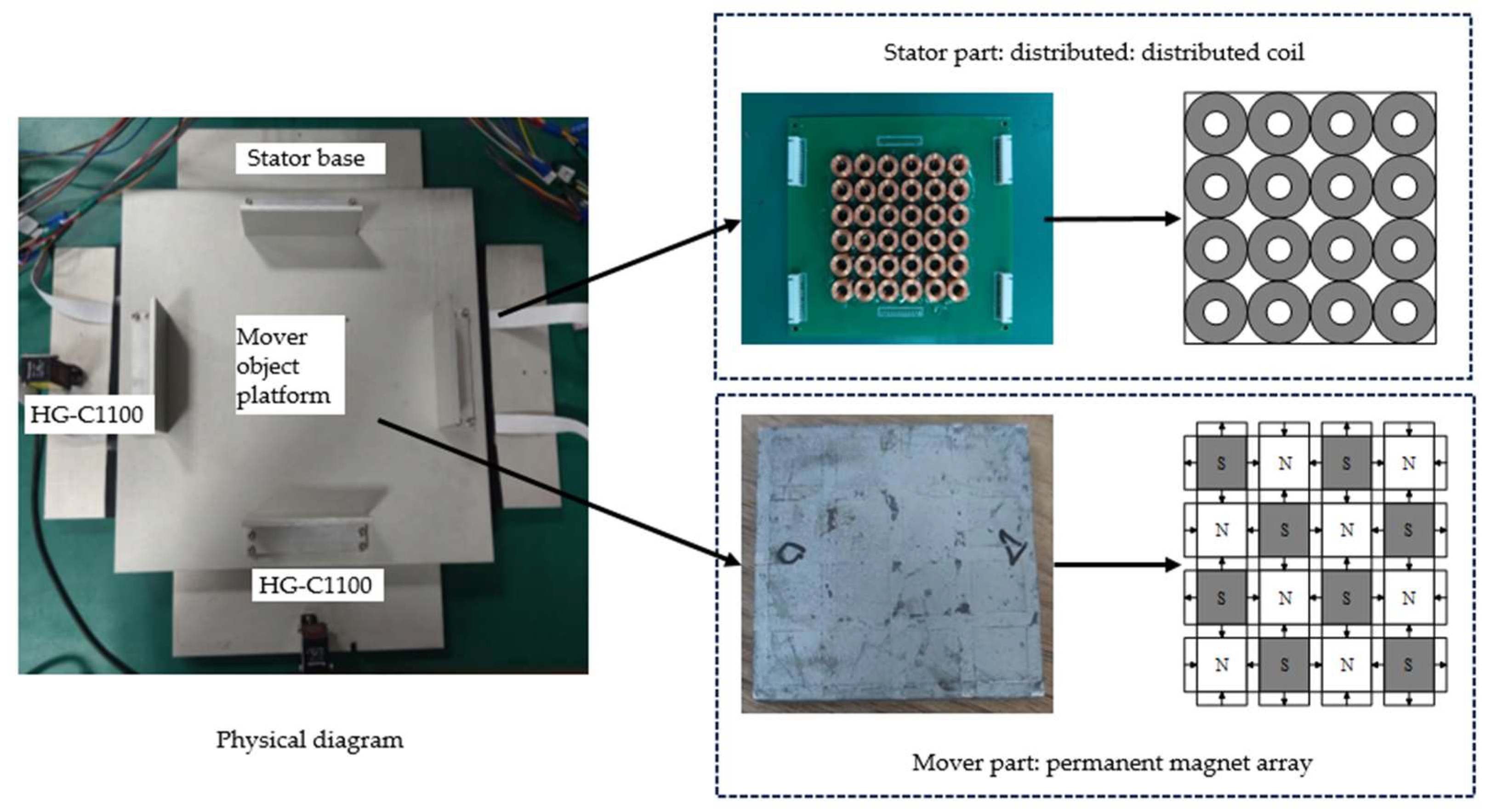
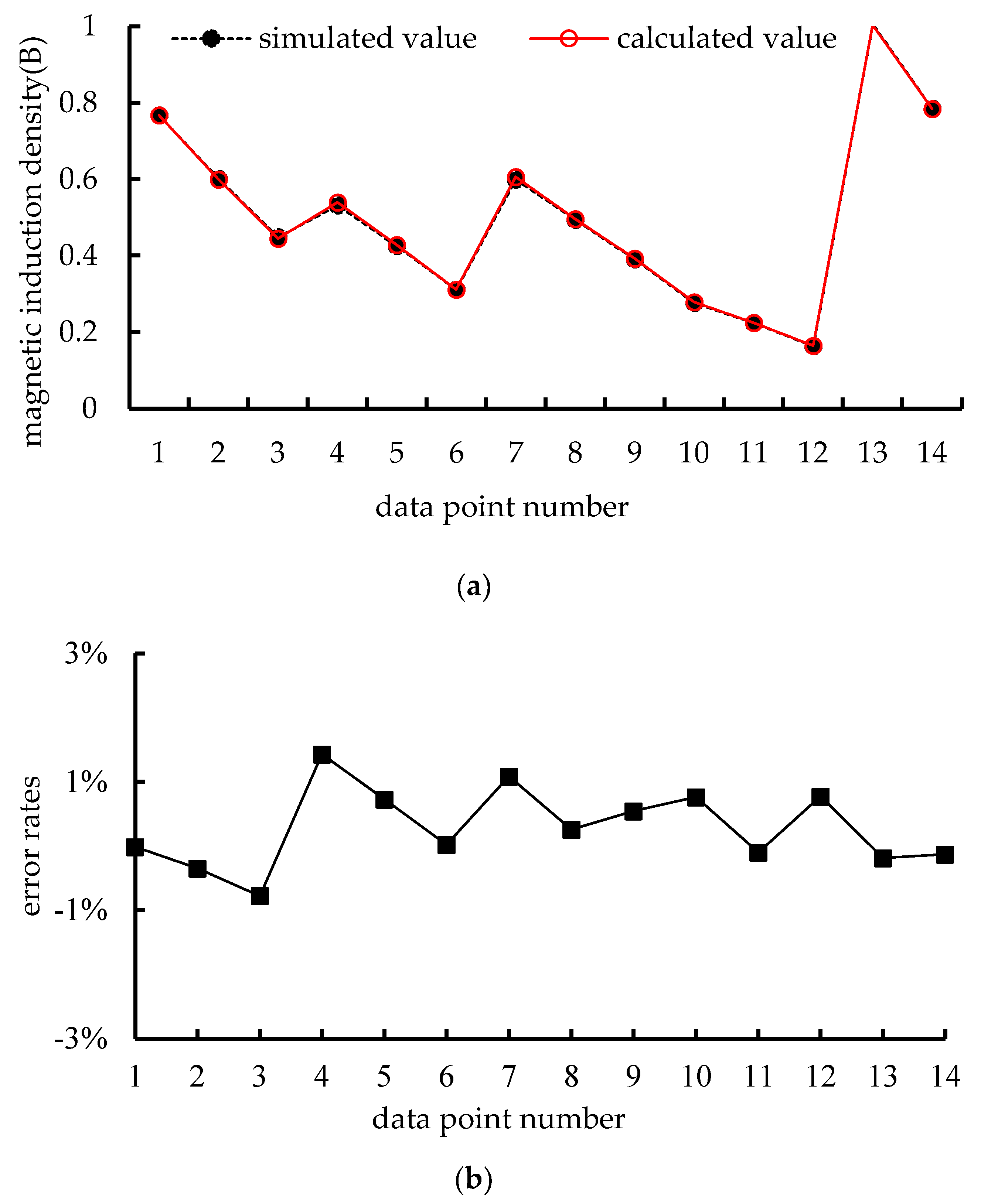

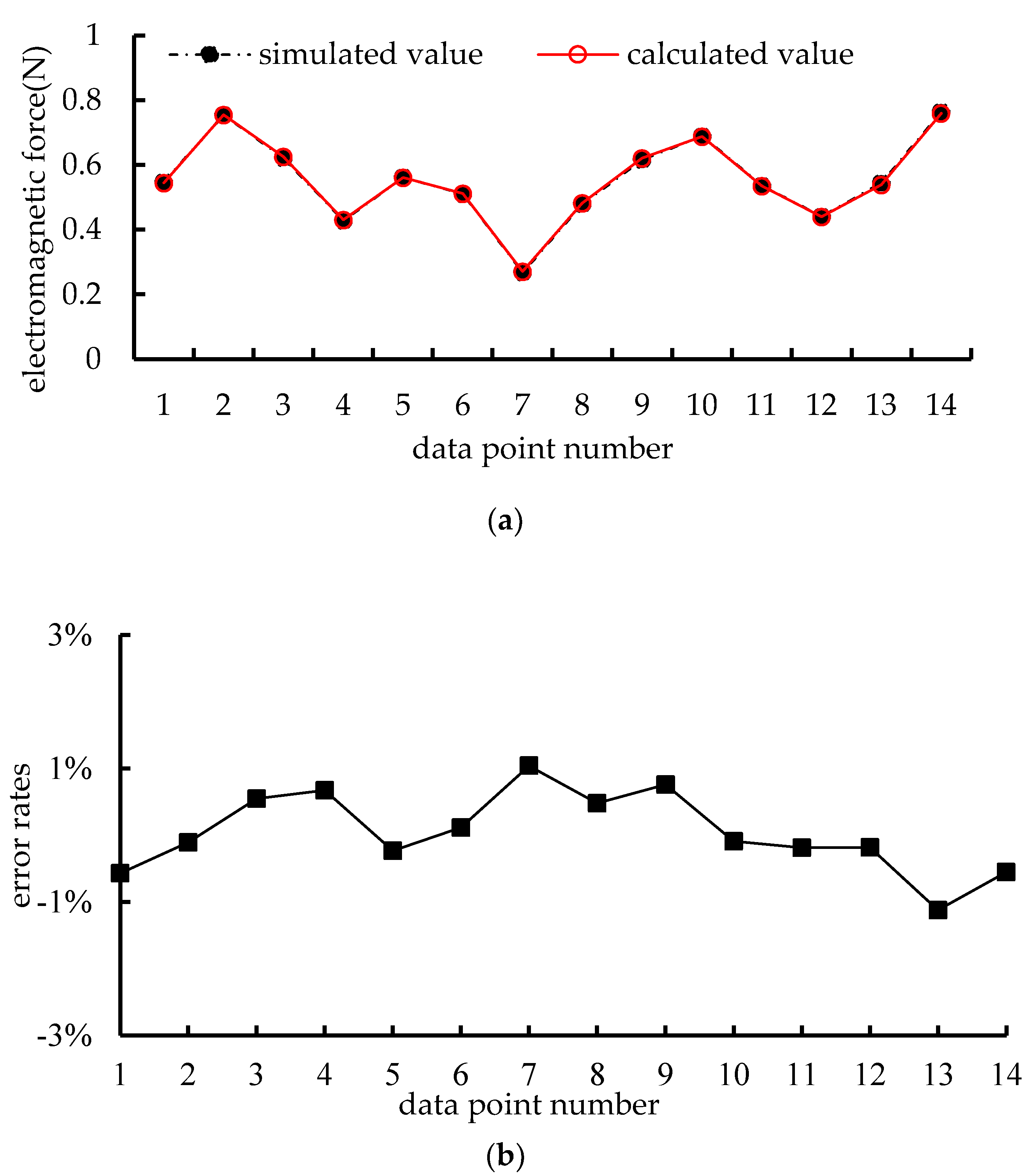
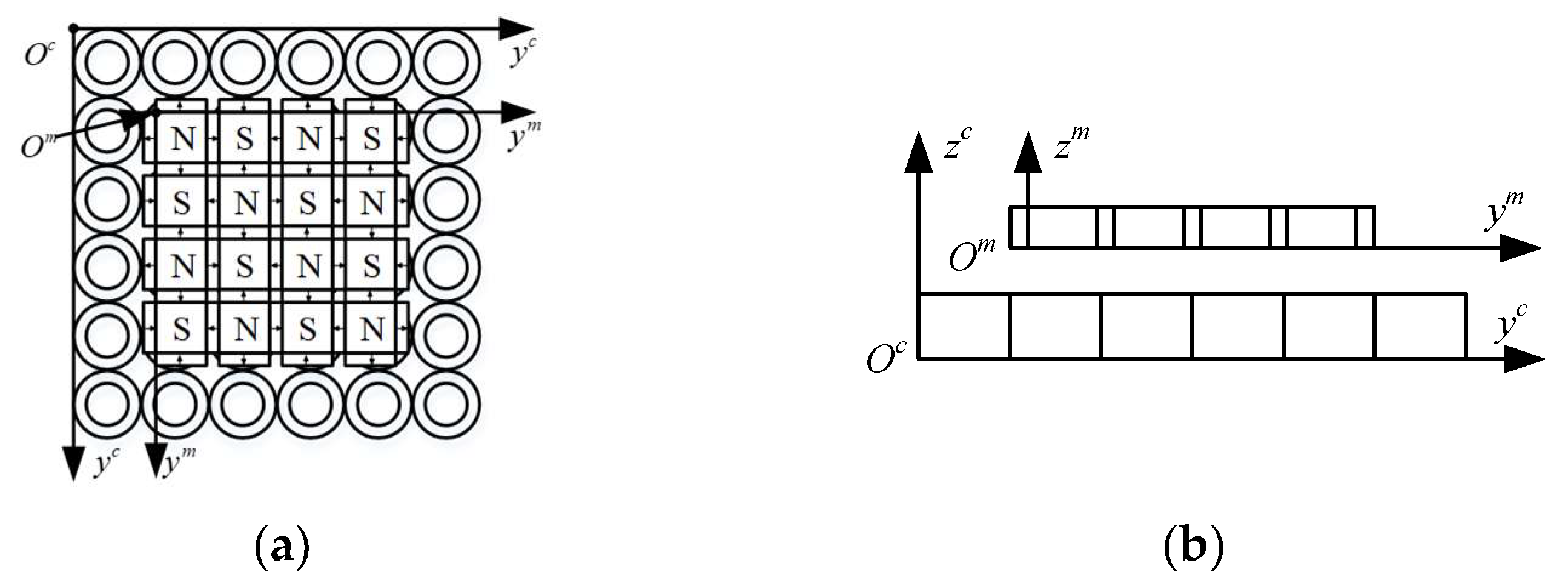
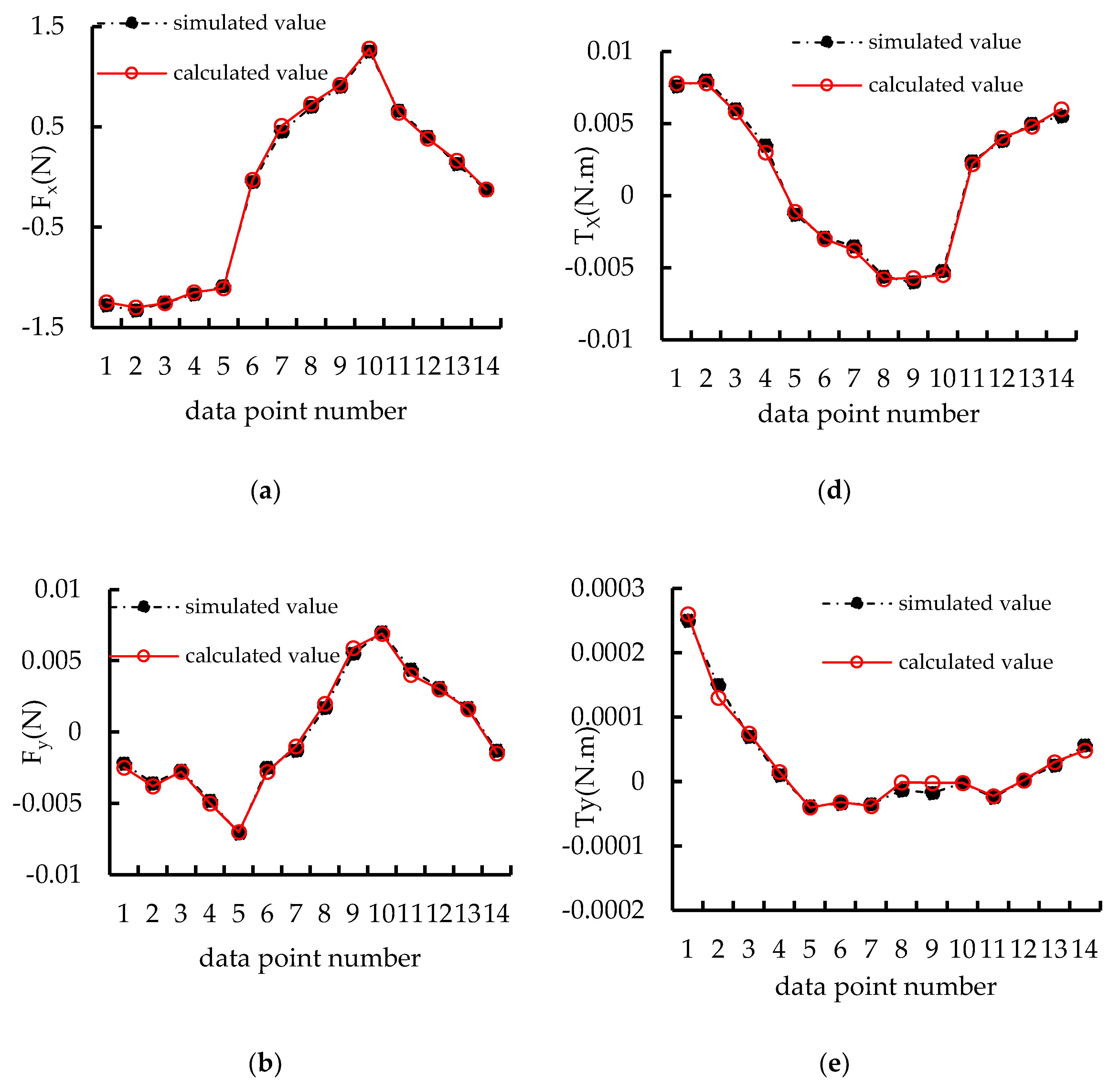






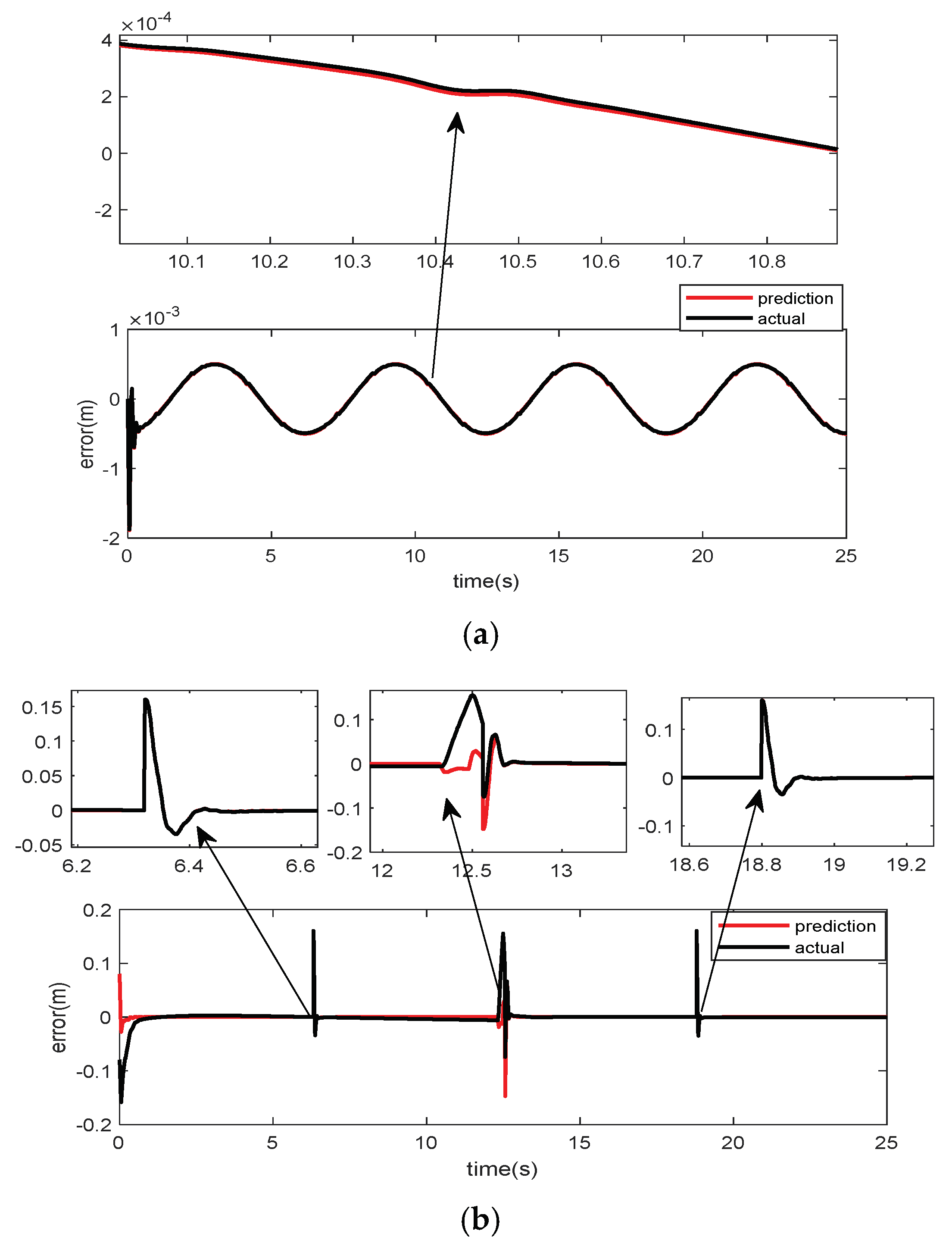
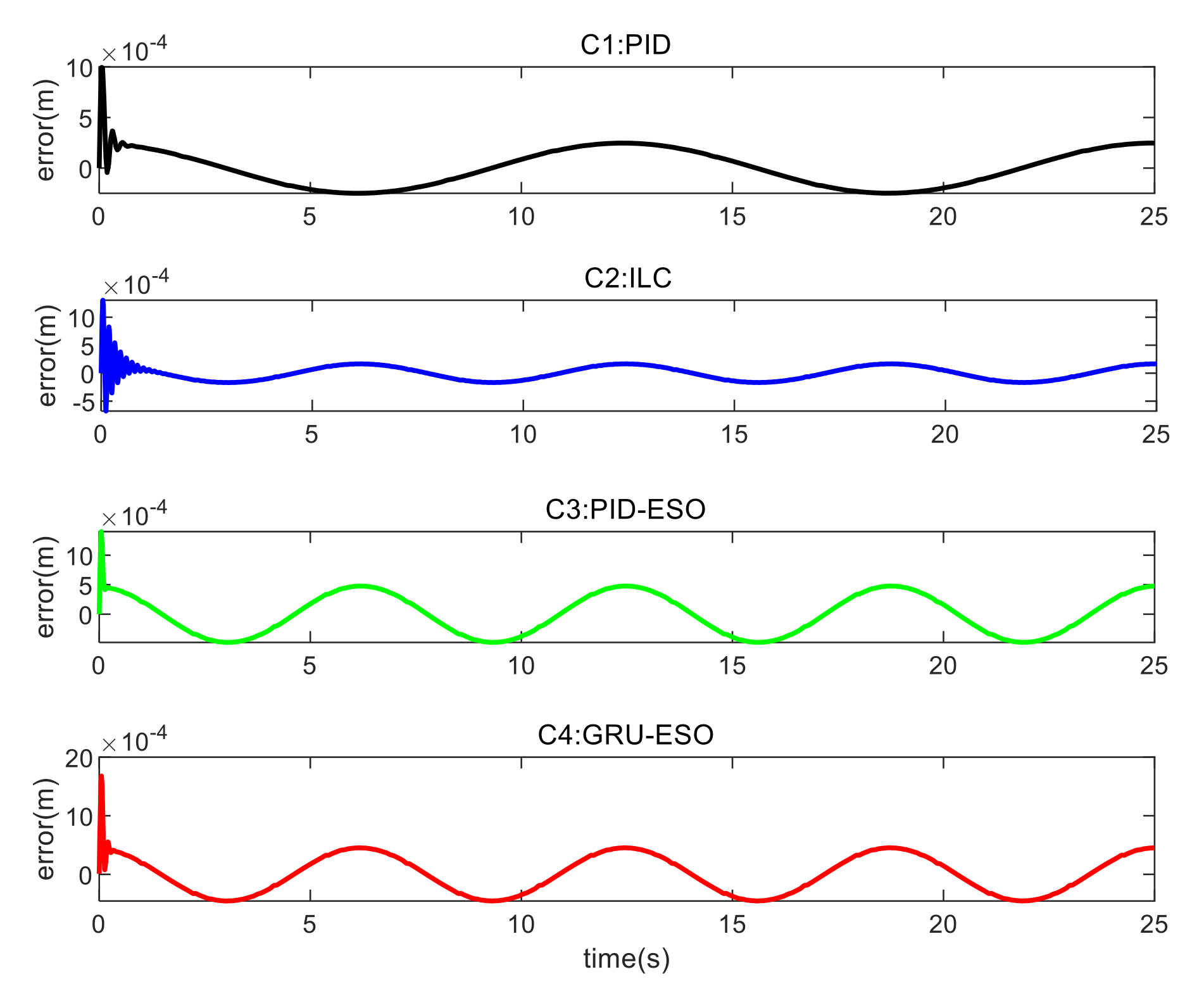
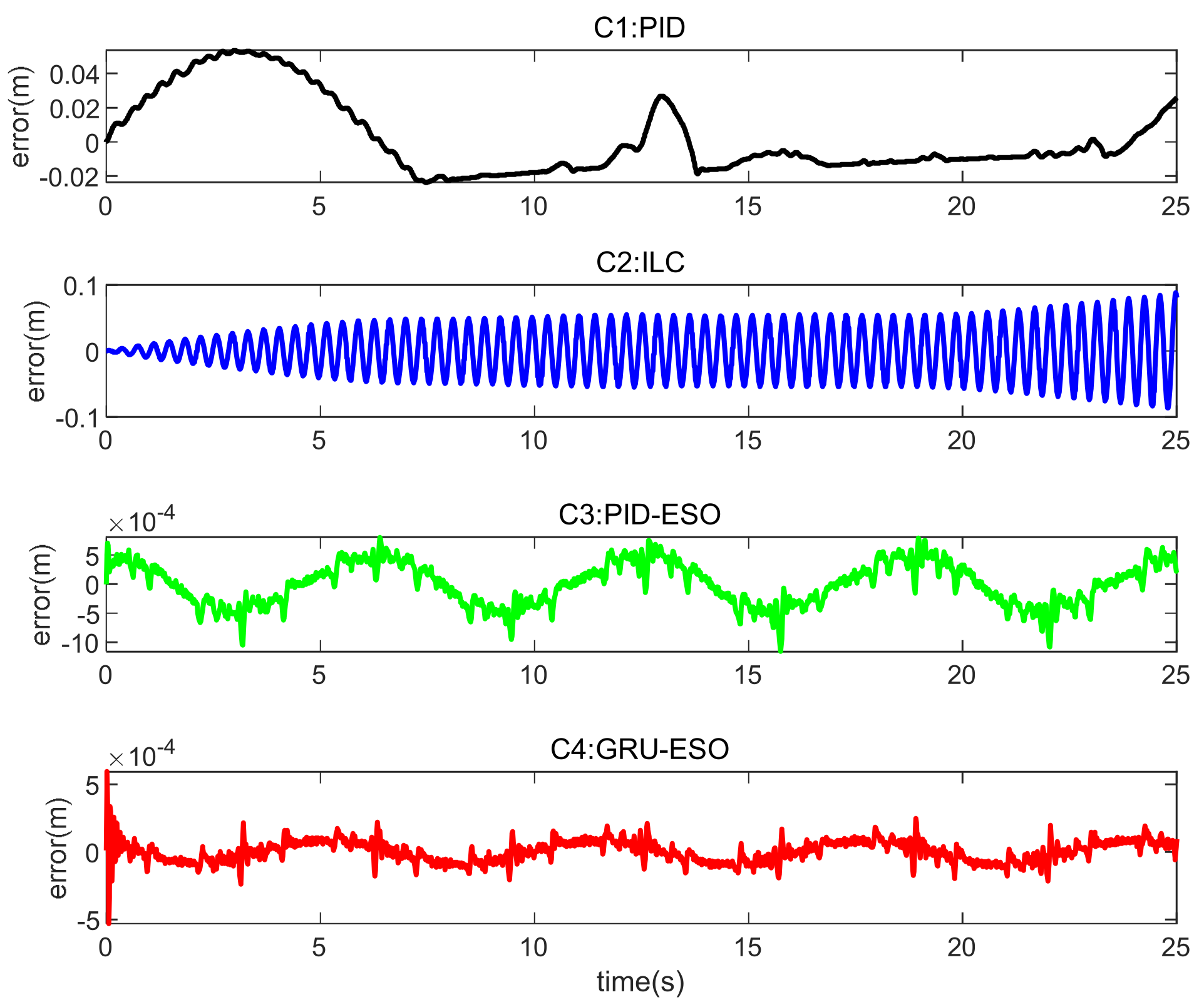

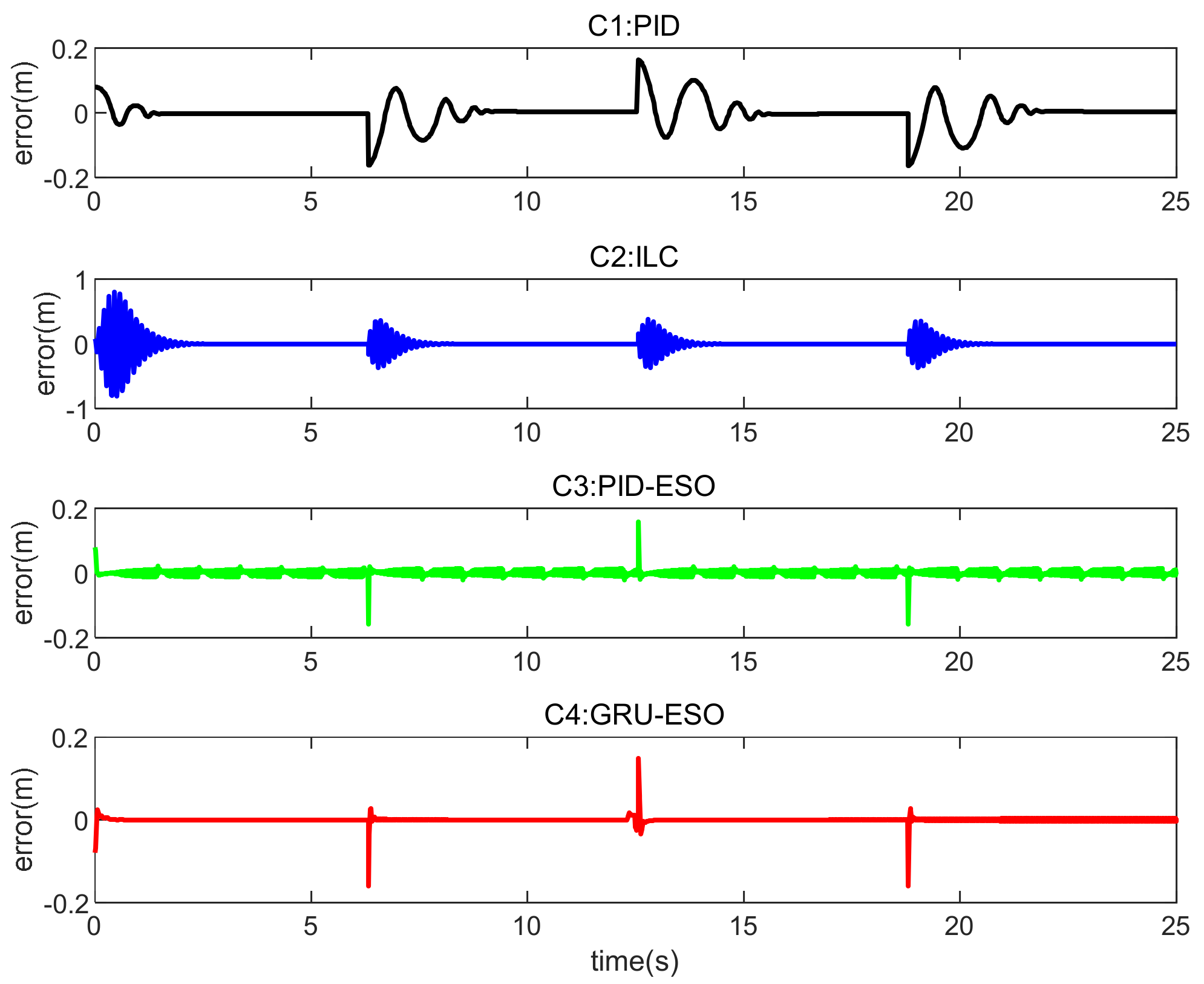

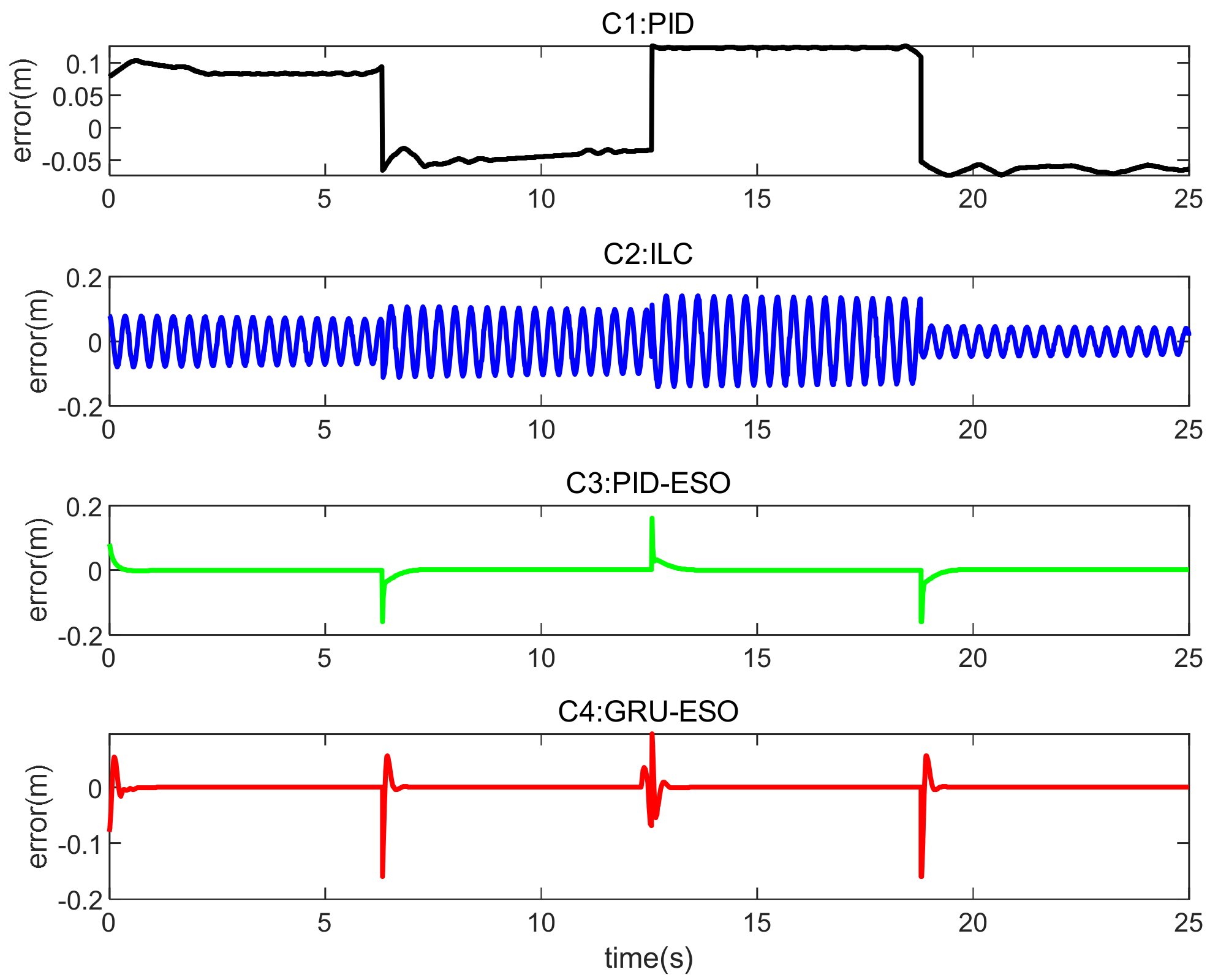
| Length (mm) | Width (mm) | Height (mm) | |
|---|---|---|---|
| Big magnet | 10 | 10 | 5 |
| Small magnet | 10 | 5 | 2.5 |
| Internal Diameter (mm) | External Diameter (mm) | Height (mm) | Resistance Value (Ω) | Sentimental Value (mH) | Wire Diameter (mm) |
|---|---|---|---|---|---|
| 8.1 | 4.5 | 14.5 | 9.9 | 7.5 | 0.25 |
| Controller | C1: PID | C2: ILC | C3: PID-ESO | C4: GRU-ESO | |
|---|---|---|---|---|---|
| Set1 | ) | 2.8431 | 3.3694 | 3.4176 | 3.2748 |
| ) | 13.9491 | 13.033 | 13.999 | 12.779 | |
| Set2 | ) | 576.94 | 372.84 | 3.6067 | 0.79021 |
| ) | 1840 | 877.6 | 11.568 | 5.9163 | |
| Set3 | ) | 353.25 | 6.6168 | 36.777 | 5.4125 |
| ) | 676.58 | 15.32 | 67.459 | 19.725 | |
| Controller | C1: PID | C2: ILC | C3: PID-ESO | C4: GRU-ESO | |
|---|---|---|---|---|---|
| Set1 | ) | 45.627 | 106.71 | 8.9061 | 7.2239 |
| ) | 163.28 | 810.07 | 157.92 | 150.2 | |
| Set2 | ) | 57.694 | 66.821 | 9.9763 | 9.609 |
| ) | 184 | 135.3 | 157.29 | 150.99 | |
| Set3 | ) | 84.88 | 67.89 | 12.176 | 11.078 |
| ) | 125.63 | 141.22 | 160.56 | 151.98 | |
Disclaimer/Publisher’s Note: The statements, opinions and data contained in all publications are solely those of the individual author(s) and contributor(s) and not of MDPI and/or the editor(s). MDPI and/or the editor(s) disclaim responsibility for any injury to people or property resulting from any ideas, methods, instructions or products referred to in the content. |
© 2024 by the authors. Licensee MDPI, Basel, Switzerland. This article is an open access article distributed under the terms and conditions of the Creative Commons Attribution (CC BY) license (https://creativecommons.org/licenses/by/4.0/).
Share and Cite
Du, C.; Ming, Z.; Ming, Y.; Liu, D.; Li, Y.; Zhao, Y. GRU-ESO Strategy for a Distributed Coil Magnetically Levitated Planar Micromotor. Micromachines 2024, 15, 740. https://doi.org/10.3390/mi15060740
Du C, Ming Z, Ming Y, Liu D, Li Y, Zhao Y. GRU-ESO Strategy for a Distributed Coil Magnetically Levitated Planar Micromotor. Micromachines. 2024; 15(6):740. https://doi.org/10.3390/mi15060740
Chicago/Turabian StyleDu, Chaofan, Zhengfeng Ming, Yue Ming, Ding Liu, Yongzheng Li, and Yuhu Zhao. 2024. "GRU-ESO Strategy for a Distributed Coil Magnetically Levitated Planar Micromotor" Micromachines 15, no. 6: 740. https://doi.org/10.3390/mi15060740
APA StyleDu, C., Ming, Z., Ming, Y., Liu, D., Li, Y., & Zhao, Y. (2024). GRU-ESO Strategy for a Distributed Coil Magnetically Levitated Planar Micromotor. Micromachines, 15(6), 740. https://doi.org/10.3390/mi15060740





